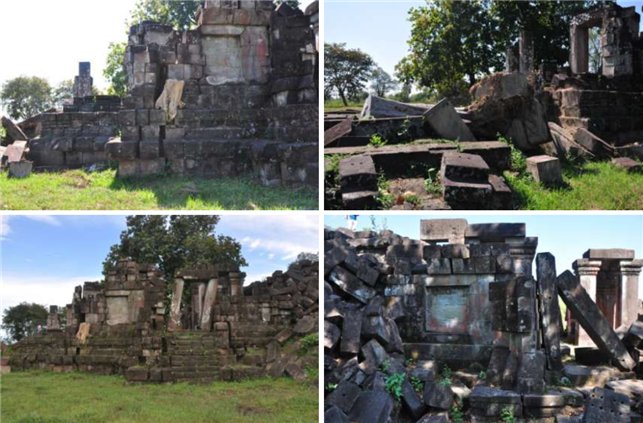 |
Hong Nang Sida, archaeological ruins surrounding the Angkorian temple in Laos. (Cultural Heritage Administration) |
Korean cultural authorities on Tuesday officially launched the restoration of the archaeological ruins at an Angkor temple in Laos, as part of the K-Heritage initiative.
According to the Cultural Heritage Administration and the Cultural Heritage Foundation, the first stage of the restoration of Hong Nang Sida (meaning chamber of Princess Sida) inside the Wat Phou Temple in the Champasak area of southern Laos kicked off on Tuesday, local time, with key officials from both countries attending. The two parties also agreed on conservation of more ruins inside the temple and its surrounding area.
The temple, believed to have been built in the 11th century, is considered the starting point of the road to the ancient Khmer monastery of Angkor Wat, a UNESCO World Heritage site. It occupies a flat area about 1.5 kilometers south of the smaller barays, or artificial bodies of water, of Wat Phou Temple, which is used today as rice fields, converted to pastures in the dry season.
As part of the first phase of the restoration project, scheduled to run through 2016, researchers dispatched from the foundation will work on restoring a platform, a foothold about 7-8 meters big, that had been destroyed, and Mandapa, the body of the main monastery inside the Hong Nang Sida, with a destroyed roof and severe damage to the walls. The team will disassemble the problematic areas, screen for recyclable parts, and then reproduce the missing parts for reassembly.
From 2017-2019 the team will work on the restoration of the memorial altar and support conservation and preservation of intangible or written heritages around the region.
The restoration aid plan is part of the K-Heritage project that the foundation launched three years ago, which is partly subsidized by the government to preserve and transmit traditional culture. It is also part of the cultural ODA project that is expected to boost ties between Korea and other Asian countries.
The foundation is also planning to hold similar projects in Cambodia and Myanmar in association with the Korea International Cooperation Agency.
“Korea has a wealth of stone-made heritage from the old days and we have an abundant pool of manpower and techniques to support the restoration,” said Kim Kwang-hee, a team manager at the foundation, in a previous interview with The Korea Herald.
By Bae Ji-sook (
baejisook@heraldcorp.com)




![[Herald Interview] 'Trump will use tariffs as first line of defense for American manufacturing'](http://res.heraldm.com/phpwas/restmb_idxmake.php?idx=644&simg=/content/image/2024/11/26/20241126050017_0.jpg)


![[Health and care] Getting cancer young: Why cancer isn’t just an older person’s battle](http://res.heraldm.com/phpwas/restmb_idxmake.php?idx=644&simg=/content/image/2024/11/26/20241126050043_0.jpg)
